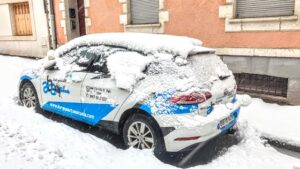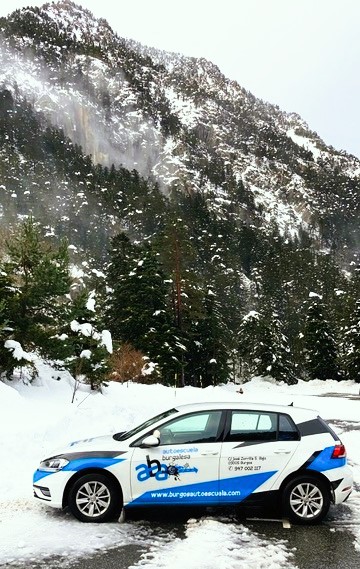Driving in snow and ice conditions presents challenges that require extra precautions while driving. Being prepared and adopting appropriate safety measures is essential to ensure a safe trip during the winter months. We usually think that it is from 0ºC when there is a risk, but the truth is that at 4ºC there is already the probability of ice on the road.
Here we present you some recommendations to confidently face driving in the snow.
Before we get going:
Check the weather forecast and road conditions before leaving. Is it really necessary to go out with your car in adverse snow conditions? If conditions are extreme, consider postponing your trip or seeking alternative, safer routes. Do not wear your coat in the car, nor do your companions, as this makes it difficult for the seat belt to function correctly.

Winter tires:
Make sure you have tires specifically designed for winter. These tires offer better traction in ice and snow conditions, improving the stability and control of the vehicle, since in summer tires, below 7ºC, the rubber loses flexibility and its grip is reduced.
Clear snow from your vehicle:
Before driving, turn on the car and let its temperature rise for a few minutes, which will help the ice crystals disappear, making it easier to break them down.
Be sure to completely clear snow and ice of all vehicle windows, mirrors and lights. This improves visibility and prevents distractions while driving.
Let us remember that it is mandatory to maintain a completely clear view throughout the vehicle. Don't be tempted to use hot water to clear your windshield: it will most likely crack due to the sudden contrast in temperature.
Drive at moderate speed:
Reduce speed considerably and maintain a safe distance between vehicles. Driving at a moderate speed provides more reaction time and helps avoid skidding and sudden loss of control of the car. Also, if there is still little snow, driving in the ruts (the marks left in the snow by the vehicles in front of us) may not be safe, since they may be frozen, which poses a risk of slipping.
However, when more snow has accumulated, starting at 5 cm, driving in the ruts of the preceding vehicles will be appropriate.
Use proper driving technique:
To circulate on the flat or on ascending slopes, you must drive at a constant speed on the highest gear that the engine allows us, as long as it is an adequate speed and to which we can control the vehicle in the event of a loss of grip.
On the contrary, andIn the case of braking and descents, we must do them well in advance, using the engine brake, reducing to lower gears and even reducing to first gear ratio, and at a constant speed.
We must do it at a speed at which, in the event of a possible loss of grip, we can regain control (and, therefore, grip) before reaching a more dangerous situation.
If your vehicle is equipped with anti-lock braking systems (ABS) It will have controlled braking, preventing the wheels from locking when braking and, therefore, avoiding loss of direction during braking.
Remember that smooth acceleration and braking They are key in winter conditions.
He ASR system (Anti Slip Regulation) It will help us in starts with little grip. Using the ABS sensors itself, it will brake the wheels that are skidding, preventing the loss of power through the drive axle differential, and will limit the engine power on the wheel that maintains grip, preventing it from slipping. All of this is controlled electronically. For it to act correctly, it is necessary to accelerate gently and constantly and let it act.
On rare occasions, it may be advisable to disconnect the system to avoid limiting the engine power.
Lights:
Keep your vehicle lights on, even during the day. Visibility may be limited in snowy conditions, and the lights make it easier for other drivers to see you.
Emergency kit:
Carry an emergency kit in your car that includes a ice scraper (made of suitable material so that it does not damage our windshield and windows, lights and rear-view mirrors), chains, blankets, non-perishable food and water. We could be forced to remain stopped for hours until traffic conditions are more favorable, so being prepared for unforeseen situations is essential in winter conditions. Also remember to bring the charged mobile and charger.
And, of course, constant concentration:
keep a conscious and alert driving attitude. Concentration on the road is crucial,
as winter conditions can change quickly.
By keeping these precautions in mind, you can significantly improve your safety when driving in snowy conditions. Preparation and caution are key to ensure safe travel during the coldest months of the year. Drive responsibly and enjoy the winter without compromising your safety.
